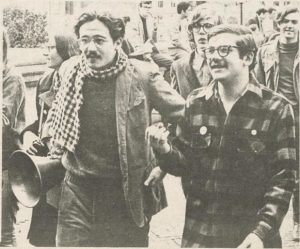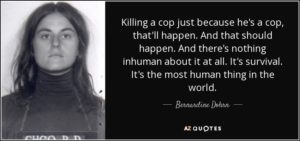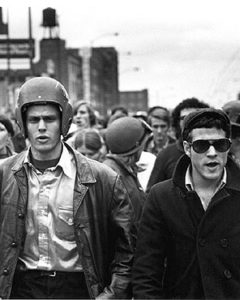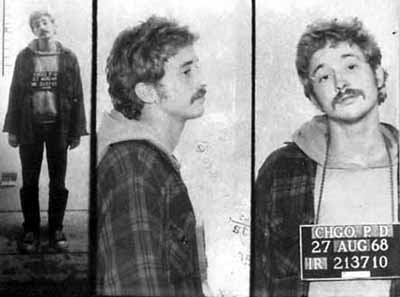Ted Gold and the Jews of Weatherman, Part 2

Ted Kaptchuk and Ted Gold from the Columbia Spectator, Volume CXIV, Number 76, 10 March 1970
Weather Terror: the New York Cell
After the Flint War Council, the Weathermen organized quasi-underground cells or “collectives” in various major cities, and began planning a terror campaign. They renamed the group “Weather Underground.” The leadership assigned Gold to one of the several Weather groups based in New York. John Jacobs, always militant, led one group. Terry Robbins, a shrimpy New York Jew who was one of the strongest advocates of the terror policy, headed the main cell, which was tasked by the leadership with finding targets to bomb. At least two gentile females were members of Robbins’ cell: Cathy Wilkerson, Robbin’s girlfriend, and Diana Oughton, Bill Ayers’ girlfriend. Also present was Kathy Boudin, member of the prominent leftist Jewish Boudin legal family. Robbins, Gold, and the women based themselves in Wilkerson’s family townhouse on 11th Street in Manhattan while her parents were on vacation.15
Gold matched the others in adopting the idea of “bringing the war home,” the Weather motto for making America’s “White power structure” feel the violence that they were inflicting on the Vietnamese. Jonathan Lerner, fellow Weatherman, recalls that he and Gold had discussed planting a bomb on a Chicago railroad to kill workers returning home at night.16 Rudd remembers that Robbins and Jacobs “would rant, “White people are pigs. This whole society has to be brought down. We have got to defeat White-skin privilege.”17 In the last days before the fatal explosion, the once mild-mannered democrat Ted Gold issued a warning that anyone defecting from the group would be subject to death, with the strong implication that he himself would kill them.18
Robbins’ cell began building a nail-studded shrapnel bomb to plant at an Army dance at Fort Dix, New Jersey. There was just one snag in their planning. None of them knew how to make a bomb.
Just before noon on March 6, 1970, the day of the planned bombing, Terry Robbins was putting the finishing touches on the crude dynamite bomb in the basement of the townhouse. He mistakenly detonated what proved to be a tremendously powerful device. The bomb instantly ripped Robbins and Diana Oughton apart. Robbins was a bit more than ripped, actually. He was shredded. The collapsing townhouse crushed Ted Gold.
I have to confess that it brings me some pleasure to relate this exquisite misadventure. Three communist terrorists destroyed with their own infernal device. Cathy Wilkerson and Kathy Boudin, occupied upstairs, were stunned but unfortunately escaped. Boudin later descended into a front “revolutionary” organization (the May 19 Communist Organization) for a sordid group of coked-up Black faux revolutionaries and helped get three gentlemen killed in the Brink’s armored car robbery in 1981. (Gold’s old buddy, the Jew David Gilbert, another “mild-mannered idealist,” is still in prison for that one. So is Judy Clark. Can you guess her ethnic background? Gilbert, described as “luminously brilliant” by a former professor, and Clark resorted to the hilarious stratagem of denying the legitimacy of the court—because they were revolutionaries you know—and refused to mount a defense. The court consequently and logically sentenced them to forever in the slammer. Boudin, however, accepted good legal advice from her father and got out after twenty years. Last time I checked she was working as—what else!—a professor at Columbia University.)
Later History: The Weather Underground
After the shock of the townhouse the Weather Underground Organization imploded. The few who remained carried on propaganda bombings—usually restrooms in government buildings—but only sporadically after 1971. They lapsed into dormancy, with a few true believers clinging to Dohrn and occasionally issuing new missives reshaping their mushy ideology. Eventually most of them “surfaced” and faced their legal charges in the late 1970s and early 1980s. They remain important only in FBI records, and in the imagination of young radicals. They accomplished exactly nothing.

Leadership of Weatherman
We must sketch out the leadership of Weatherman. The charismatic, attractive Dohrn seems to be the key to understanding the power nexus in the group. She had burst upon the radical scene with the looks and verve well calculated to awe the often-homely Jews of the movement (her mother was Swedish, according to Wikipedia). She quickly became the lover of John Jacobs, the swaggering militant and Marxist theoretician who provided much of the thrust behind Rudd at Columbia. Together Dohrn and Jacobs planned and carried out the break with SDS that birthed Weatherman. They dominated Weatherman for its first year, until the townhouse.
Mark Rudd was briefly in the top leadership group. He rode his fame from the Columbia strike into a prominent role for Weatherman, but faded in importance, unwilling or unable to match the bent for violence of the others. Jim Mellen and Bill Ayers were two non-Jews in early leadership positions. Mellen was an older theoretician who worked with Ayers in Ann Arbor, but he quickly left the group when he realized how set on violence they were. Ayers, however, became one of the most important and enduring leaders of the group. Jeff Jones was another non-Jew with a lengthy tenure in the leadership. Jones and Ayers were, tellingly, both lovers of Dohrn after she moved on from Jacobs, and both derived significant authority from the liaison. Dohrn’s power is revealed also in the fact that she was the main mover in the expulsion of Jacobs from the organization after the townhouse; he was made a scapegoat for the “error.” Dohrn continued in the acknowledged top spot for years. She issued the communiques and drove the agenda.
Others among the top leadership were Terry Robbins (obviously short-lived), Howard Machtinger (cousin of Ted Gold), Robbie Roth, Eleanor Raskin (both later added to the “Central Committee”), and Ronald Fliegelman. All Jews. Fliegelman stands out in this group because he became the bomb-maker. After the townhouse, he volunteered to master the art of bomb-making and reportedly manufactured most or all of the bombs that Weather subsequently used. One of the Weathermen later said that without him, “there would be no Weather Underground.”19

John Jacobs (left) and Terry Robbins
The top theoreticians of Weatherman were Jacobs, Mellen, and Dohrn. The top militants were Robbins, Ayers, and Jacobs. The person in the brightest spotlight throughout was Dohrn.
The Jewish cohort seems to diminish slightly as one descends into the middling leadership group, and then again into the rank-and-file. However, this is hard to calculate exactly, as it is hard to gauge the membership.
Motivation of Weatherman
What was the motivation of Gold and the other Jews of Weatherman? What part did their Jewish background play? Motivations are complicated, but I am willing to grant the Weathermen a measure of idealism. Men virtually always strive toward some good they see in a course of action; vanishingly few are perverse and strive for something they know is evil. Gold and the Weathermen apparently felt very deeply for peoples of color and the struggles they faced. Gold’s father donated his time to serve the poor and Ted volunteered to tutor Blacks in Harlem. However, the idealism of the Jews of Weatherman was perverted; it was a canopy that also sheltered self-interest, murder and lust for power. Idealism also varied; it was the entire motivation for some, but very weak for others. We have seen that at least some of the radicals were utterly cynical in their use of issues. Probably the idealism was purer in the beginning, and faded in the fire.
Another aspect to consider in plumbing the depths of motivation is self-deception. Self-interest so easily and imperceptibly cloaks itself with morality. Kevin MacDonald discusses this matter perceptively in his discussion of the Left (p. 90ff) in Culture of Critique. Radical Jews, in common with many humans, often have little awareness of their own motivations, and not even the deeper ones.
There is plenty of evidence that the Jews of Weatherman were motivated by Jewish concerns.
The Jews of Weatherman were not benighted caftan-wearers stumbling out of the ghetto armed with rabbinic injunctions against the goyim; they were middle- or upper-class youth strutting onto top universities mindful of parental injunctions against the goyim. Not much of a difference. Mark Rudd provides choice testimony in this regard: “What outraged me and my comrades so much about Columbia, along with its hypocrisy, was the air of genteel civility. Or should I say gentile? Despite the presence of so many Jews in the faculty and among the students . . . the place was dripping with goyishness . . . Certainly I reveled in my role of head barbarian within the gates.”20
Then there is the emotional reaction to perceived injustice. Cathy Wilkerson remembers, “From the first, Teddy Gold had a deep sensitivity to injustice. This was encouraged and deepened by the stories his parents . . . told about the treatment of their families as Jews in Eastern Europe and Russia.”21 Wilkerson, a good friend of Gold, must have gotten this information straight from him. If so, it must have occupied his thoughts a good deal, and nurtured resentment.
National Socialist Germany and the holocaust figured prominently in the minds of the Weathermen, even before the holocaust became such an omnipresent phenomenon in American culture. A major Weatherman motif was the need to avoid standing by and allowing injustice to occur; they often reiterated the need to avoid being like the “good Germans” who did not resist but simply “went along.” Rudd says, “World War II and the holocaust were our fixed reference points. This was only twenty years after the end of the war. We often talked about the moral imperative to not be Good Germans.”22
David Gilbert’s parents taught him, “unambiguously,” that racism was wrong. “These values grew out of their experiences being Jewish following the Holocaust,” he wrote later. David’s first essay was about the “wonderfully accomplished” life of a man named Carl; the essay ended “But none of the above ever happened because Carl was killed, as a young boy, in a concentration camp.”23
Within a typically Jewish perspective, these Weathermen easily transferred their perceptions of National Socialist Germany to the US government. After all, both regimes were White, were they not? Not much difference in Jewish minds. It is a neurological fact that outsiders find it hard to discern variations within a different race. Rudd again: “We saw American racism as akin to German racism toward the Jews. As we learned more about the [Vietnam] war . . . we started describing the war as racist genocide, reflecting the genocide of the holocaust. American imperialist goals around the world were to us little different from the Nazi goal of global conquest.”24 [Emphasis added.]
Other sources insist radical Jews are motivated by “tikkun olam,” the purported holy imperative to “heal the world.” Rudd has a most hilarious rejoinder. “As a kid in Maplewood [attending synagogue] I never heard of tikkun olam, the now well-known commandment to repair the world. For all I know, Michael Lerner made the whole thing up.”25 (Lerner was a sixties radical turned progressive rabbi.) Rudd is hitting pretty close to the mark here; see this. “Tikkun olam” apparently does not represent a tradition of Jewish concern for justice in the outer world, but merely a concern for better implementation of laws within the Jewish world.
There are other, more minor, but still indicative Jewish aspects to the Weatherman phenomenon. David Horowitz and Peter Collier in their superb account describe the attraction that Jeff Jones, a blond California gentile, felt to the Weatherman leaders, “Like other WASPs, he was attracted to the Jewish drama of the new group and to ‘struggle sessions’ during which Rudd, Robbins, and J.J. [John Jacobs] histrionically argued their positions.”26 Here we see the intense verbal interplay and knowledge of texts that is a traditional element of Jewish life.
Another gentile, Bill Ayers, in his pretentious and often mendacious memoir, gives this odd reaction to his immersion in Marx coupled with the unjust expulsion of a Jewish friend from school:
I didn’t want to be a goy. I drew a Star of David and the word Jew on my forearm . . . recolored it for weeks and kept it hidden under my jacket. In Kerry’s honor, and for Marx as well, I invented another identity, part rootless, wandering scholar, part brilliant if ill-tempered Moor—I imagined myself a Jew.27

Bill Ayers mugshot
Conclusion
Weatherman was a movement led almost wholly by Jews, concerned deeply with Jewish themes, and straining fanatically towards a potentially genocidal communist dictatorship in which they could hold untrammeled power over the Whites of America. The movement evoked half a dozen earlier communist movements, each with their clique of Jewish leaders bent on revenge.
Thankfully, Weatherman was a tiny movement, virtually powerless against the vast and stable American society and government. Tragically, however, they and their leftist peers have carried out the Gramscian “long march” through American society and have shaped much of the country to their image. Dohrn, Boudin, and Ayers have all been employed by prestigious universities. Virtually all American institutions are presently committed to the attack on “White privilege.”
Have the Weathermen triumphed after all? Will the attack on Whites proceed from historical monuments and free speech, to flesh and blood? It seems likely. Patriots, brace yourselves.
Endnotes
- Information on Gold’s youth can be found in two short biographies: Kirkpatrick Sale, “Ted Gold: Education for Violence,” in Weatherman, edited by Harold Jacobs (Ramparts Press, 1970), 470-484, and Flying Close to the Sun: My Life and Times as a Weatherman by Cathy Wilkerson (New York: Seven Stories Press, 2007), 396-98.
- Sale, 474.
- Stanley Rothman and S. Robert Lichter, Roots of Radicalism: Jews, Christians, and the New Left. (New York: 1982), 80-83; Kevin MacDonald, The Culture of Critique: An Evolutionary Analysis of Jewish Involvement in Twentieth-Century Intellectual and Political Movements. (2002), 76-77. See also Mark Rudd, “Why Were There so Many Jews in SDS? (Or, the Ordeal of Civility).” Viewed July 11, 2017. http://www.markrudd.com/?about-mark-rudd/why-were-there-so-many-jews-in-sds-or-the-ordeal-of-civility.htm
- Mark Rudd, Underground: My Life with SDS and the Weathermen (New York: 2010), Ch. 3. See also Sale, 474-76.
- Here is a view of Ignatiev from the right. Here is another. See also “Theodore Allen” in Wikipedia.org. Robin Morgan, the Jewish feminist, was told by an unnamed Weatherwoman that she had no right to have the male “pig” baby [i.e., White] she was holding. Morgan, no shrinking Leftist violet, was shocked. “How can you say that? What should I do?” she asked. “Put it in the garbage,” the Weatherwoman told her. This story appears in Abe Peck, Uncovering the Sixties: The Life and Times of the Underground Press (New York: Pantheon Books, 1985), 217.
- For Weatherman ideology, see John Jacobs, et.al, “You Don’t Need a Weatherman to Tell Which Way the Wind Blows,” in Harold Jacobs, 51-90. See also Rudd, Underground, 147-48.
- Mark Rudd, Underground, 115.
- Rothman and Lichter, Roots of Radicalism, 35.
- Kevin MacDonald, The Culture of Critique, Note 83.
- For an account of this “council,” see David Horowitz and Peter Collier, Destructive Generation: Second Thoughts About the ‘60s (New York: Summit Books, 1990), 95-7. See also “Stormy Weather” in Harold Jacobs, 341-50.
- “Stormy Weather” in H. Jacobs, 343.
- Mark Rudd, Underground, 194.
- Larry Grathwohl, Bringing Down America (New Rochelle: Arlington House, 1976), 183-84.
- Stephane Courtois, et. al., The Black Book of Communism: Crimes, Terror, Repression (Cambridge: Harvard University Press, 1999), 103-04. The passage can be viewed here.
- Good descriptions of the New York cell can be found in Bryan Burrough, Days of Rage: America’s Radical Underground, The FBI, and the Forgotten Age of Revolutionary Violence (New York: Penguin, 2015), 92 and 100-05; in Rudd, Underground, 192-94; and in Cathy Wilkerson, Flying Close to the Sun (New York: Seven Stories Press, 2007), 324-44.
- Bryan Burrough, Days of Rage, 93.
- Mark Rudd, Underground, 192.
- Mark Rudd, Underground, 197.
- Bryan Burrough, Days of Rage, 125
- Mark Rudd, “Why Were There so Many Jews in SDS?”
- Cathy Wilkerson, Flying, 396.
- Mark Rudd, “Why Were There so Many Jews in SDS?”
- David Gilbert, Love and Struggle: My Life in SDS, the Weather Underground, and Beyond (Oakland: PM Press, 2012), 15
- Mark Rudd (Why Were There so Many Jews in SDS?)
- Mark Rudd, “Why Were There so Many Jews in SDS?
- Horowitz and Collier, 80-81
- Bill Ayers, Fugitive Days: Memoirs of an Antiwar Activist (Boston: Beacon Press, 2009), 38.





Comments are closed.